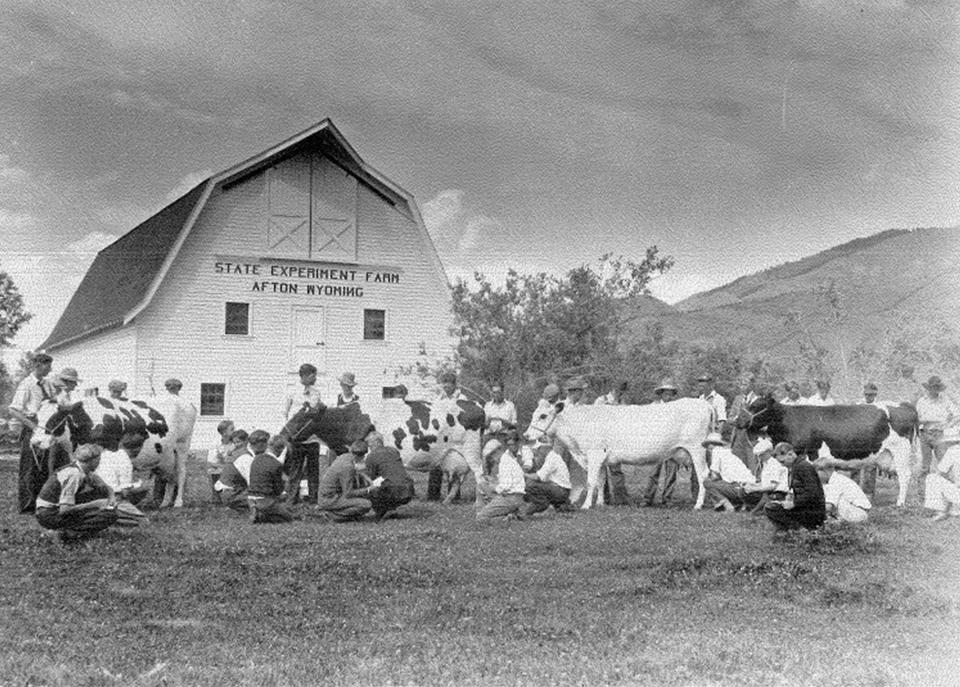Time, Cheese and People in Star Valley
We were lucky last weekend to visit Star Valley for the Wyoming Historical Society’s annual trek. During two days of talk and bus rides we learned about the area’s history, geography, beauty—and isolation. Only two paved routes lead there. One heads west from Kemmerer, turns north, slaloms along the Idaho border past Cokeville, comes up over a high pass and descends finally into the drainage of the north-flowing Salt River—Star Valley. The other route comes south from Jackson, crosses the Snake River at Alpine and continues south through a narrow canyon of the Salt until the valley, green and especially lush this wet year—opens out.
Cheese, people say in Star Valley, is milk trying to become immortal. For five or six generations the dairy business dominated the valley; it’s been called “Little Switzerland.” But by the beginning of this century, dairying there had become economically unsustainable; the cheese factory in Thayne closed in 2005. Now, only one dairy remains in the valley—Shumways, a boutique operation that makes thick, delicious yogurt and ice cream for tourists like us. Greco-Roman heavyweight wrestler Rulon Gardner, Olympic gold medalist in 2000, gained his great strength and good nature growing up on a Star Valley dairy farm; Gardners were among the valley’s earliest Mormon settlers.
Valley trails and paths were long used by Native people attracted by the area’s plentiful game—and salt deposits. White people first came to the valley in fur trade times; the Lander Cutoff, a government-sponsored shortcut from South Pass to Fort Hall in present Idaho entered the valley from the south end, ran north 15 miles on the valley floor before exiting to the northwest. The road was finished in 1858 and became a well-used route for emigrants and commercial freight; within just a few years, we learned, enterprising freighters were using it to export industrial quantities of salt for use smelting impurities out of gold in the gold camps and mills of western Montana.
Mormon settlers from Utah and Idaho territories came into the valley in the 1870s. They began the dairy business there, also running beef cattle and hundreds of thousands of sheep, which grazed all summer on the high mountain slopes. Montpelier, Idaho, on the Oregon Short Line Railroad, was a harrowing four-day-round-trip wagon journey to the southwest. There, Star Valley-ites shopped, loaded their cheese and wool onto trains—and banked.
One August day in 1896, George Waite of Star Valley was in the Montpelier bank with his four-year-old son, George Albert. For generations, we learned, George Albert told how his father and a few other customers were persuaded by some men with pistols to turn to the wall of the bank and place their hands high on the wall. One of the pistol men, whom George Albert remembered clearly as he’d worked around his father’s ranch the previous summer, leaned down and gave the boy a penny, telling him to run across the street and buy some candy. Until then the man was known, among other names, as George Cassady—only after that robbery did newspapers attach to him the name “Butch.”
Of course, there are plenty more stories in the valley—outlaw stories, freighting stories, survival stories and stories of romances gone wrong and right. Only in the 19-teens did Star Valley’s isolation become less severe, when a bridge was built over the Snake River at the north end and a better road—the Convict Road—built in from the south by inmates released for the purpose from the State Honor Farm in Riverton.
Though the dairy farms are nearly all gone and there are few sheep, there are still plenty of beef cattle in the valley. And the valley remains heavily Mormon; a new LDS temple, a 12-foot gold-leaf statue of the Angel Moroni topping its 123-foot spire, was completed in Afton in 2016.
We offer special thanks to Star Valley Historical Society members Ron Anderson and Lane Allred, among many, many others, for hosting us last weekend. The Wyoming Historical Society boasts chapters in nearly every county in Wyoming; Lincoln County has two chapters, because the history of Star Valley is so wildly different from the coal-mining and railroad history that dominates Kemmerer in the southern part of the county.
For its part, the Wyoming Historical Society runs two-day treks every June and general membership meetings every September. These gatherings are a great way to understand how geography and topography shape what happens in a place over time—and to meet people of all ages fascinated by the idea. The September meeting will be in Cody the weekend after Labor Day. Hope to see you there!
Read:
Lincoln County, Wyoming
The Lander Trail: National Road Building Comes to Wyoming
Butch Cassidy in Wyoming

